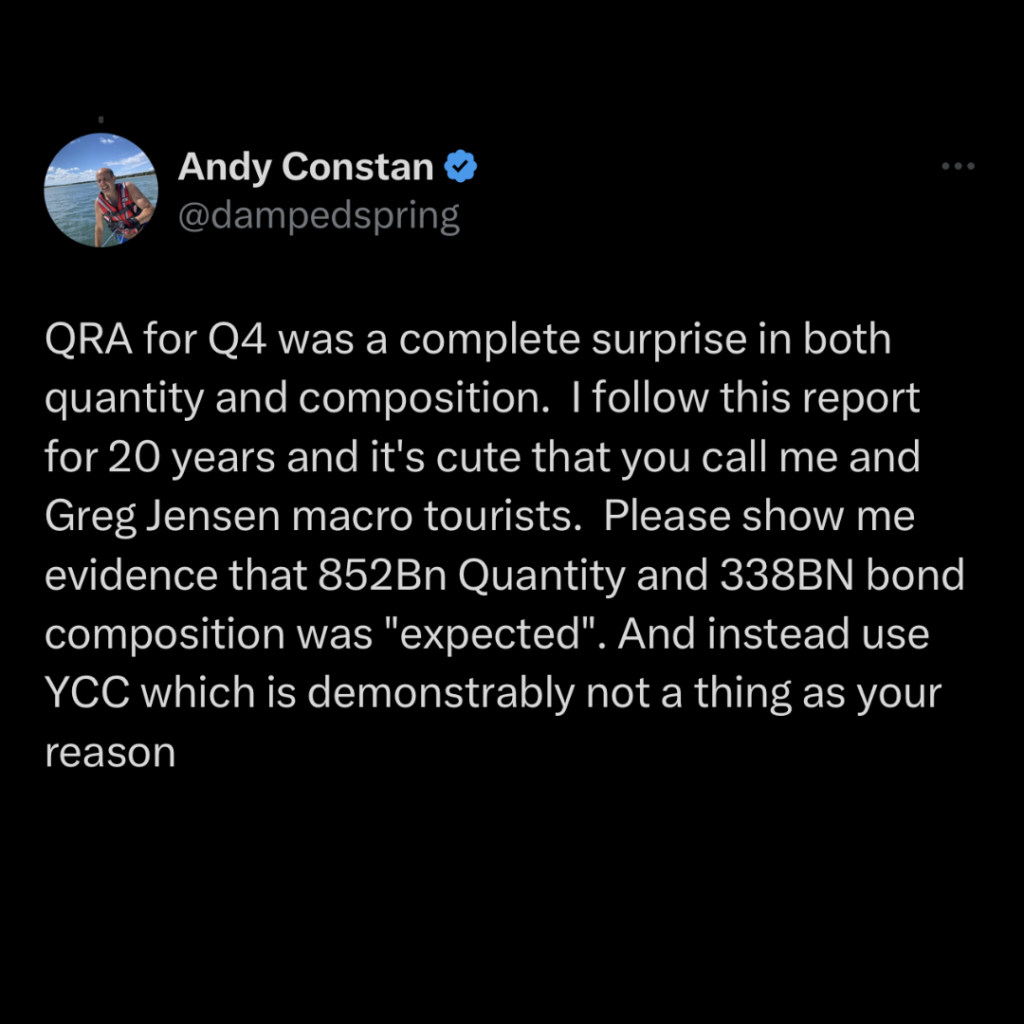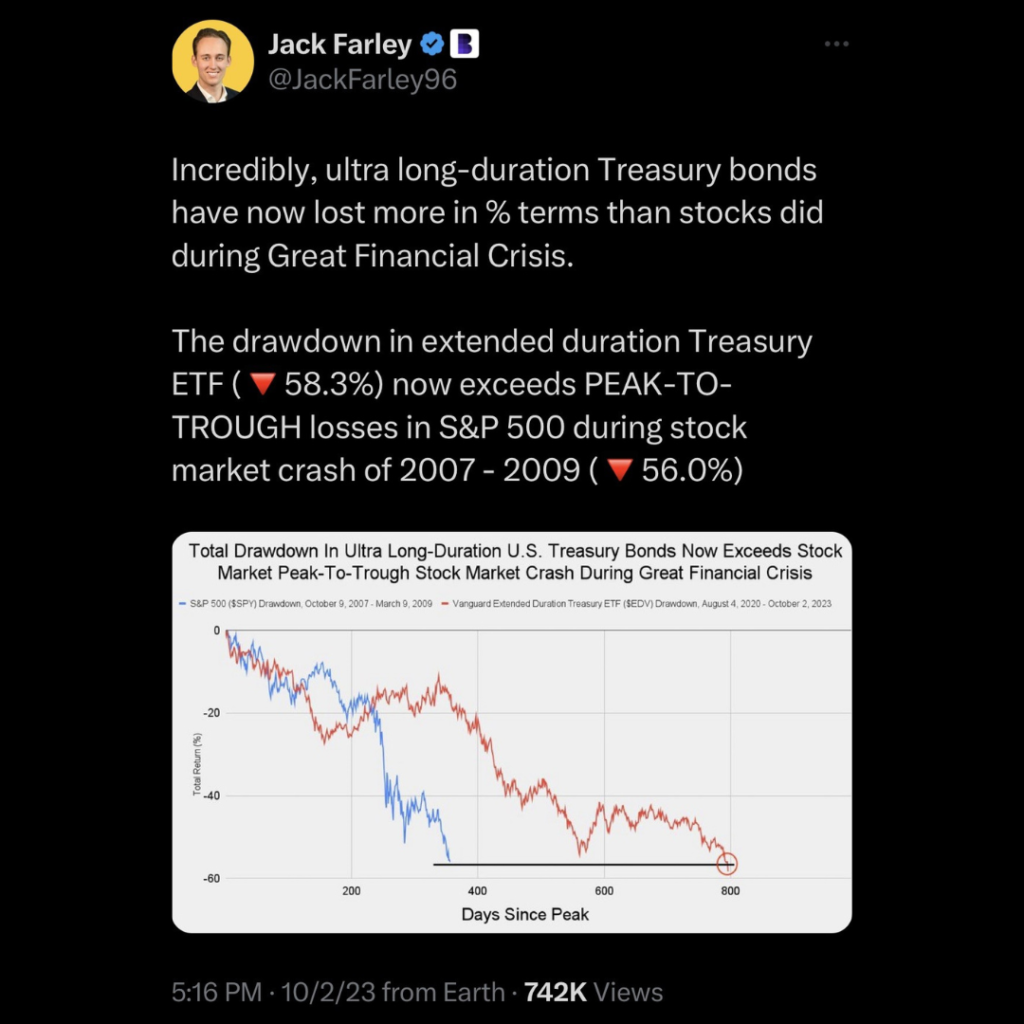
Macro Minute: Week of October 16, 2023
With this dramatic drawdown in fixed income, I feel like I need to talk about rates again. Many people are confused why long-term interest rates are moving higher. This is happening at a time when inflation has come down a lot and is in a more reasonable spot. It is important to remember that most financing is based off of the 10-year treasury, not the Federal Funds Rate that is controlled by the Federal Reserve. Watching these long-term rates is important to see how tight financing will be in the overall economy going forward. Let’s dig in and see what is going on.
Let’s start with who are the typical buyers of these long-term treasuries.

Warren lays out in a quick synopsis what has happened. Let’s go through the mechanics. The federal government is funded by issuing new treasury bonds. These bonds are auctioned off and are bought by the five players Warren names. The Federal reserve is no longer doing Quantitative Easing (QE) and is engaged in Quantitative Tightening (QT). So, they are not buying currently. Foreigners as Warren calls them, are foreign governments. For many different reasons, they are no longer meaningful buyers of treasuries. (That is a topic for another Macro Minute sometime.) Banks are no longer meaningful buyers other than maintaining liquidity and reserve requirements. So that leaves pension funds, hedge funds, and households. Pension funds buy to maintain a match to their liabilities and are a steady buyer. Hedge funds and households are looking at it from an opportunity cost perspective, meaning if they buy more bonds, it is at the expense of something else. In the case of hedge funds and households, they may use margin to increase bond purchases or they may sell equities or use excess cash. These last two players will most likely be more willing to buy bonds with higher yields because they can be assured if they just hold them until maturity, they will make the return of the yield.
In summary, there are limited buyers, and the buyers that remain are more price sensitive.
Let’s look at the supply of bonds.

Full disclosure, I take Andy’s research. Here Andy is replying to someone on twitter/X? why he thinks that rates have went on this latest move higher. I touched on the QRA before here and the TGA here. Quick refresher, the QRA is the US Treasury announcement letting the market know how much and the composition the supply of bonds/bills will be in the coming quarter while the TGA is basically the US Treasury checking account. As the TGA is spent down, it means that there will be extra supply of bonds being issued in coming quarters and vice- versa if the TGA is high it means that less bonds will need to be issued. This year, because of the budget debate in congress, the TGA was brought to very low levels and had to be refilled. That is the quantity Andy is referring to and add into that, there was a large component of longer duration bonds announced too.
In other words, supply was higher than the market was expecting.
While this Macro Minute has run a little longer than normal, I think it’s an important topic. There are less buyers of bonds than has been at a time when the quantity supplied is larger. Many people will make hyperbolic statements about how this will end, but the here and now of it is that we are in an environment of higher rates being offset by a strong economy and fiscal deficits.
DISCLOSURES:
Please remember that past performance may not be indicative of future results. Different types of investments involve varying degrees of risk, and there can be no assurance that the future performance of any specific investment, investment strategy, or product (including the investments and/or investment strategies recommended or undertaken by Longview Financial Advisors, Inc.), or any non-investment related content, made reference to directly or indirectly in this newsletter will be profitable, equal any corresponding indicated historical performance level(s), be suitable for your portfolio or individual situation, or prove successful. Due to various factors, including changing market conditions and/or applicable laws, the content may no longer be reflective of current opinions or positions. Moreover, you should not assume that any discussion or information contained in this newsletter serves as the receipt of, or as a substitute for, personalized investment advice from Longview Financial Advisors, Inc. To the extent that a reader has any questions regarding the applicability of any specific issue discussed above to his/her individual situation, he/she is encouraged to consult with the professional advisor of his/her choosing. Longview Financial Advisors, Inc. is neither a law firm nor a certified public accounting firm and no portion of the newsletter content should be construed as legal or accounting advice. A copy of the Longview Financial Advisors, Inc.’s current written disclosure statement discussing our advisory services and fees is available upon request.
